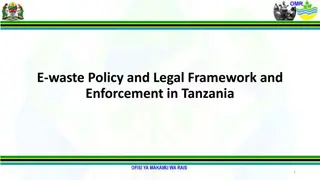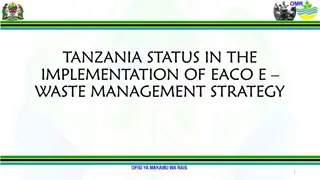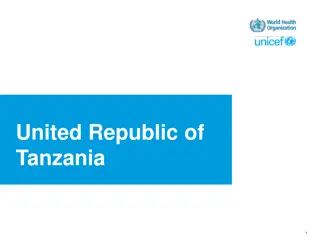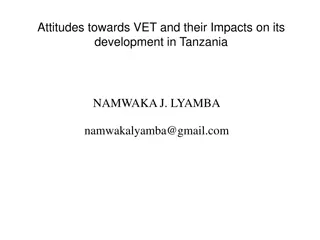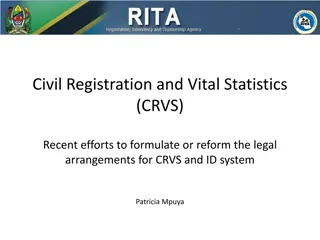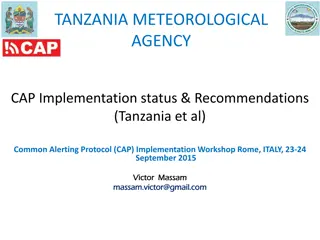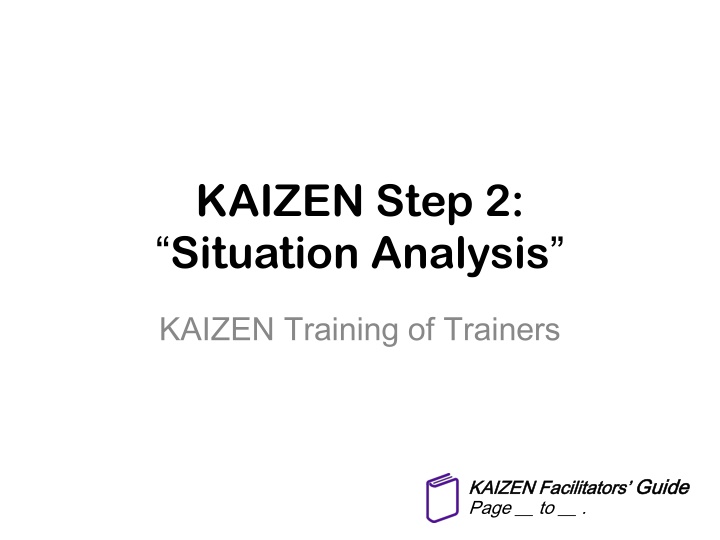
Effective Steps for KAIZEN Situation Analysis Process
Explore the comprehensive process of situation analysis in KAIZEN training, covering topics like defining situation analysis, Pareto chart utilization, and more. Learn the step-by-step approach to identifying contributing factors, collecting measurable data, and setting targets for improvement.
Download Presentation

Please find below an Image/Link to download the presentation.
The content on the website is provided AS IS for your information and personal use only. It may not be sold, licensed, or shared on other websites without obtaining consent from the author. If you encounter any issues during the download, it is possible that the publisher has removed the file from their server.
You are allowed to download the files provided on this website for personal or commercial use, subject to the condition that they are used lawfully. All files are the property of their respective owners.
The content on the website is provided AS IS for your information and personal use only. It may not be sold, licensed, or shared on other websites without obtaining consent from the author.
E N D
Presentation Transcript
KAIZEN Step 2: Situation Analysis KAIZEN Training of Trainers KAIZEN Facilitators KAIZEN Facilitators Guide Page __ to __ . Guide
Objectives of the session At the end of the session, trainees are able to: 1) Define what is situation analysis in KAIZEN process 2) Describe process of situation analysis 3) Describe how to develop and utilize Pareto chart properly 4) Demonstrate the process of situation analysis 1
KAIZEN Process STEP 7 Standardization Check effectiveness of countermeasure STEP 6 STEP 5 Implementation of countermeasure STEP 4 Identification of countermeasure STEP 3 Root Cause Analysis STEP 2 Situation Analysis STEP 1 Selection of KAIZEN theme 2
Steps of situation analysis in KAIZEN process Identify measurable data and information Define Identify contributing factors [1] [2] [3] methodologies for data collection Develop a calculation table [6] [5] [4] Develop Pareto chart Conduct data collection [7] Set target 3
Steps of situation analysis in KAIZEN process 1 2 3 4 5 6 7 Identify measura ble data and informati on Define methodol ogies for data collection Identify contributi ng factors Develop a calculatio n table Conduct data collection Develop Pareto chart Set target 4
Steps of situation analysis (1) Steps of situation analysis (1) 1. Brainstorm to identify contributing factors of the problem (KAIZEN theme) Contributing factor 1 Contributing factor 2 Contributing factor 4 Contributing factor 3 Large problem is composed of several contributing factors. Large Problem Large Problem 5
Steps for Situation analysis (2) Steps for Situation analysis (2) 2. Identify measurable data and information of each identified contributing factor 3. Identify methodologies of the data collection; - Period of data collection (maximum 1 months) - Kinds and number of data source: retrospective data or prospective data - Collection method 6
Steps for Situation analysis (3) Steps for Situation analysis (3) 4. Conduct data or information collection according to the methodologies 5. Develop a calculation table of frequency and its accumulation ratio to compile the data 7
Example of calculation table KAIZEN Theme is Giving wrong medication is reduced iving wrong medication is reduced Before KAIZEN Cumulative frequency SQ # Contributing factors Contributing factors Accumulation ratio Frequency Number of giving wrong injectable medicines 1 25 25 46% Number of giving wrong inhale medicines Giving wrong oral medicines Giving wrong volume of insulin Number of giving wrong ointment Total Total 2 16 41 76% 3 4 5 6 5 2 47 52 54 - 87% 96% 100% - 54 Calculation formulas will be explained on the next slide Descending order 8
Points of development of calculation table Contributing factors will be put in descending order of its frequency Cumulative frequency = (its frequency) + (the previous cumulative frequency) Accumulation ratio = (each cumulative frequency) (Grand total of frequency) 100 Please see next slide!! 9
Steps for Situation analysis (4) 6. Develop Pareto chart based on the data table, to identify prior contributing factor(s) to be solved Calculationtable Pareto chart 10
What is Pareto chart? Cut off line is 80% It is a type of chart that contains both bars and a line graph, where individual values are represented in descending order by bars, and the cumulative total is represented by the line One of the seven basic tools of quality control http://en.wikipedia.org/wiki/Paret o_chart 25 100.0 90.0 20 80.0 80.0 Accumulation ratio (%) Accumulation ratio (%) 70.0 15 60.0 Frequency Frequency 50.0 10 40.0 30.0 5 20.0 10.0 0 0.0 1 2 3 4 5 Contributing factor Contributing factor Frequency Accumulation ratio (%) Example of Pareto chart 11
Pareto principle It is also called as 80:20 rule rule It is a technique helps to identify the top 20% that needs to be addressed to resolve the 80% of the problems 80:20 Vilfredo Federico Damaso Pareto, Italian economist, developed this concept 12
Necessity of Pareto chart in Necessity of Pareto chart in KAIZEN Process KAIZEN Process To identify large contributing factors If the large contributing factor(s) is solved, the situation with the problems will be improved effectively and easily Reduced by eliminated the contributing factor 1 Proble m Contributing factors Situation with problems before KAIZEN (100% of the problem) Situation with problems after KAIZEN (reduced problem) 13
(Example) Data table and Pareto Chart Pareto Chart Maximum number of the axis shall match with the frequency of the first faactor Before KAIZEN SQ # Contributing factors Contributing factors Cut off line is 80% FrequencyCumulative Accumulatio n ratio 25 100.0 frequency 90.0 Number of giving wrong injectable medicines Number of giving wrong inhale medicines Giving wrong oral medicines Giving wrong volume of insulin Number of giving wrong ointment Total Total 80.0 80.0 Accumulation ratio (%) Accumulation ratio (%) 20 1 25 25 46% 70.0 Frequency Frequency 15 60.0 50.0 2 16 41 76% 10 40.0 30.0 3 6 47 87% 5 20.0 4 5 52 96% 10.0 0 0.0 5 2 54 100% 1 2 3 4 5 Contributing factor Contributing factor Frequency 54 - - Accumulation ratio (%) Period of data collection: 31stJanuary 2014 to 30thFebruary 2014 (30 days) Data source: medication and treatment chart Number of investigated patient (chart): 50 Methodologies of data collection need to be described clearly. 14
Target setting The last step of KAIZEN Step 2 is target setting Desire and target is different We want to reduce 70% of the problem! This is our target of KAIZEN What is the reason of 70% reduction of the problem?? We just want Is it just your desire? It is important to explain the reasons of your target setting. 15
Pareto rule can be useful for target setting Ideally, 80% of the problem (vital few) is the target of the KAIZEN based on Pareto rule. But it is difficult!! In the example above, if your target is 46% reduction it means to solve all of the 1stcontributing factor 87% reduction it means to solve all of the 1st, 2ndand 3rdcontributing factors) 16
Cont. Our target is to reduce 46% of number of giving wrong injectable medicines. Target setting By when? By September Number of giving wrong injectable medicines What? How? 46% reduction * Do not forget: Need to consider the problem is still remained even if you achieve your target 17



